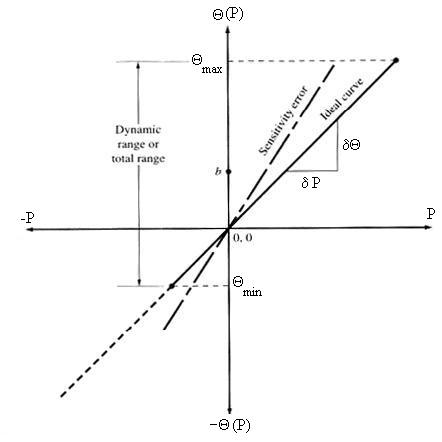 |
|
||
|
Pressure Sensor Characteristics
Sensitivity is defined as a normalized sensor output signal change per unit pressure change to reference signal:
where θ is the output signal and ∂θ is the change in it due to the applied pressure ∂P. The definition is illustrated in folloving figure:
The most sensitive sensors are used for pressure measurements in the range from 0 to 10 kPa The sensitivity error is a departure from the ideal slope of the characteristic curve (shown as a dotted curve in the previous figure).
Dynamic range is the pressure range over which the sensor can provide a meaningful output.
Full-scale output (FSO) of a pressure sensor is simply the algebraic difference of the end points of the output. Nominal pressure range is the pressure range for which the sensor complies with given data. Maximum pressure range is the maximum pressure the sensor can withstand without damage. Linearity refers to the proximity of the device response to a specified straight line. Often specified in terms of percentage of nonlinearity (NL), which is defined as:
where DPmax is the maximum input deviation, PFS is the maximum, full-scale input.
Offset error of a transducer is defined as the output that will exist when it should be zero.
Resolution is the smallest detectable incremental change of pressure that can be detected.
Temperature coefficient of sensitivity (TCS) is:
where S is the sensitivity at the reference temperature, and T is the temperature. Temperature coefficient of offset (TCO) is the value of the output signal at a reference pressure, such as when ∂P = 0.
where θ0 is the offset at the reference temperature, and T is the temperature. Temperature coefficient of bridge resistance (TCR) concerns piezoresistive pressure sensors that use a Wheatstone bridge
where R is the bridge resistance at the reference temperature, and T is the temperature. g-sensitivity is the effect of the gravity on the sensor output.
Related r
|
 Accelerometer
Accelerometer






